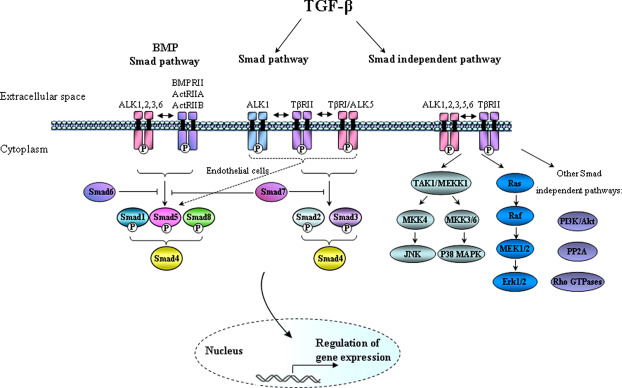What is TGFBR2 Protein
The TGFBR2, or Transforming Growth Factor Beta Receptor II, is a cellular protein in humans encoded by the TGFBR2 gene. It is an integral component of cellular signaling and growth. TGFBR2 was discovered in 1992 through the advancement in molecular biology and genomics by molecular biologists who recognized its importance due to its known association with various disease states.
Situated within the human chromosome 3, TGFBR2 gene occupies the 3p22 locus. Like other proteins, TGFBR2 is composed of amino acid chains that fold into a unique three-dimensional conformation, referred to as its protein structure. The protein structure includes the serine/threonine kinase domain and the ligand-binding domain essential for its function in signal transduction.
Function of TGFBR2 protein
Functionally, the TGFBR2 protein is part of the Serine/Threonine protein kinase family, which are known to mediate various cell processes, such as cell growth, adhesion, and differentiation. Specifically, the TGFBR2 protein acts as a receptor, receiving signals from the Transforming Growth Factor-beta (TGF-β), a class of cytokines protein. When TGF-β binds to the TGFBR2 protein, it activates the receptor, thus instigating various downstream cellular processes like cell proliferation, apoptosis (cell death), and differentiation.
TGFBR2 protein related signal pathway
The TGFBR2 protein and its function have a significant role in a fundamental signal transduction pathway known as the TGF-β signaling pathway. In this pathway, TGF-β ligands bind to the TGFBR2 protein, which in turn activates the associated Transforming Growth Factor Beta Receptor I (TGFBR1). This activation then phosphorylates and activates SMAD proteins - SMAD2 and SMAD3. These proteins interact with SMAD4, translocate to the nucleus, and regulate gene transcription. In essence, such a complex pathway manages multiple cellular processes pivotal to the growth and functioning of an organism.

Fig1. TGF-β signaling through Smad-dependent and Smad-independent pathways. (Veronica Lifshitz, Dan Frenkel, 2013)
TGFBR2 protein related diseases
Further, research has identified TGFBR2 protein's involvement in numerous disease states. For instance, mutations in the TGFBR2 gene or problems with the TGFBR2 protein lead to genetic disorders like Marfan syndrome and Loeys-Dietz syndrome. IAdditionally, it fosters a conducive environment for cancer progression. Studies link TGFBR2 gene mutations to colorectal, gastric, and endometrial cancers due to abnormal cellular growth and proliferation functions, implying significant implications for cancer research.
TGFBR2 protein's applications in biomedical
Today, the TGFBR2 protein has firmly established itself within the sphere of biomedicine. The determination of the molecular pathways lead by TGFBR2 has opened an array of opportunities for the development of diagnostic and treatment options for numerous diseases. Testing for mutations in the TGFBR2 gene can provide early diagnosis for diseases like Marfan syndrome and certain cancers. In addition, interventions targeted at the TGFBR2 protein structure, preferably at the kinase domain, might inhibit TGF-β signaling and put a stop to abnormal cell proliferation, therefore becoming a possible treatment strategy for cancer and other diseases.
In conclusion, a detailed understanding of the TGFBR2 protein and the roles it plays in the human body provides insights into our body's normal functioning and disease progression. Its pivotal role in vital cell processes and links to various disorders help researchers understand the disease's pathogenesis, leading to the development of novel diagnostic and therapeutic strategies. As research further unlocks the complexities of this protein, its full potential in the biomedical field would be harnessed.
Our Featured Products
| Cat.No. | Product Name | Species | Source (Host) | Tag |
|---|---|---|---|---|
| TGFBR2-697H | Active Recombinant Human TGFBR2, Fc-tagged, Biotinylated | human | Human Cell | Fc |
| TGFBR2-152H | Recombinant Human TGFBR2, Fc-His tagged | human | Human Cell | Fc/His |
| TGFBR2-444H | Recombinant Human TGFBR2, GST-tagged, Active | human | Sf9 Insect Cell | GST |
| TGFBR2-0797H | Active Recombinant Human TGFBR2 protein, Fc-Avi-tagged, Biotinylated | human | HEK293 | Fc-Avi |
| TGFBR2-703H | Recombinant Human TGFBR2 Protein, MYC/DDK-tagged | human | HEK293 | Myc/DDK |
| TGFBR2-1290H | Recombinant Human TGFBR2 Protein (L50-D159), His tagged | human | E.coli | His |
| GFBR2-0796H | Active Recombinant Human TGFBR2 protein, His-Avi-tagged, Biotinylated | human | HEK293 | His-Avi |
| RFL14015HF | Recombinant Full Length Human Tgf-Beta Receptor Type-2(Tgfbr2) Protein, His-Tagged | human | E.coli expression system | His |
| TGFBR2-8814C | Recombinant Cynomolgus TGFBR2, Fc tagged | Cynomolgus Monkey | Human Cell | Fc |
| TGFBR2-4503R | Recombinant Rhesus Macaque TGFBR2 Protein, His (Fc)-Avi-tagged | Rhesus Macaque | HEK293 | His (Fc)-Avi |
Reference
- Veronica Lifshitz, Dan Frenkel, in Handbook of Biologically Active Peptides (Second Edition), 2013

